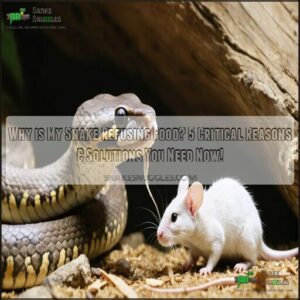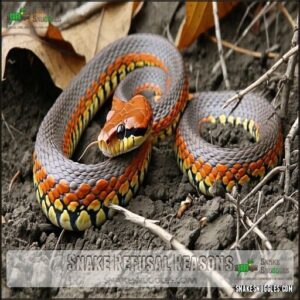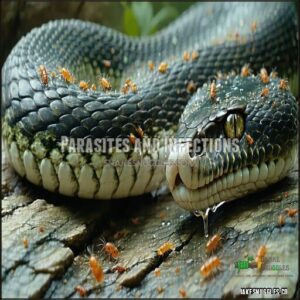This site is supported by our readers. We may earn a commission, at no cost to you, if you purchase through links.
 If your snake’s refusing food, don’t panic just yet—it happens more often than you might think.
If your snake’s refusing food, don’t panic just yet—it happens more often than you might think.
Common reasons include shedding (who wants a meal when they’re already stressed?), brumation during colder months, or even improper enclosure conditions like temperature or humidity being off-kilter.
Health issues, such as parasites or infections, can also play a role, though a vet can help rule those out.
Sometimes, snakes are just picky eaters or adjusting to a new environment, and the trick is to monitor their behavior carefully and make gradual changes to help your snake dine happily again.
Curious about the exact steps to help your snake dine happily again? Keep reading!
Table Of Contents
- Key Takeaways
- Snake Refusal Reasons
- Why Snakes Refuse Food
- Environmental Factors Matter
- Health Issues and Appetite
- Managing Snake Appetite Loss
- Frequently Asked Questions (FAQs)
- Why is my snake refusing to eat?
- What does it mean if a snake doesn’t eat?
- Why do captive snakes refuse food?
- Why does my pet snake not eat?
- How do you know if a Snake refuses to eat?
- Why do pet snakes go off their food?
- How can I encourage my snake to eat?
- How to tell if a snake is starving?
- How often should I feed my snake?
- Can snakes refuse food after hibernation?
- Conclusion
Key Takeaways
- Check your snake’s enclosure setup—improper temperature, humidity, or lack of hiding spots often causes stress and refusal to eat.
- Natural reasons like shedding, brumation, or breeding cycles can temporarily suppress your snake’s appetite, so monitor behavior patterns.
- Watch for health issues such as respiratory infections, parasites, or mouth rot, and consult a vet if your snake’s food refusal lasts several weeks.
- Avoid handling before feeding, offer appropriately sized fresh prey, and create a calm environment to encourage eating.
Snake Refusal Reasons
Your snake’s refusal to eat isn’t always cause for panic, as issues from natural shedding cycles to environmental stressors can trigger this behavior.
A snake skipping meals might just be shedding or stressed—check the basics before worrying about bigger health issues.
Understanding these common reasons will help you determine whether your snake’s feeding strike requires simple adjustments to its habitat or a more urgent trip to the veterinarian, which can be triggered by issues such as environmental stressors.
Natural Causes of Appetite Loss
While your snake’s refusal to eat might seem alarming, many natural factors can cause appetite loss.
Pre-molt anorexia commonly occurs during shedding cycles, when your snake’s energy redirects to skin renewal.
Brumation fasting happens during colder months, even with consistent enclosure temperatures.
Female snakes often display gravid refusal during pregnancy, while males might eat less during breeding season.
These natural metabolic slowdowns help snakes conserve energy, so don’t panic immediately if your snake isn’t eating, as these periods can be a normal part of their metabolic cycle.
Environmental Factors Affecting Appetite
While natural cycles can pause your snake’s appetite, its environment often plays a bigger role.
Your snake’s home setup directly impacts whether it’ll eat or go on hunger strike.
- Incorrect thermal gradient prevents proper digestion
- Low humidity levels can cause dehydration and stress
- Poor enclosure design without adequate hiding spots creates insecurity
- Bright lighting or excessive noise triggers defensive behaviors
Check these environmental conditions first when your snake refuses food—temperature and humidity imbalances are often the culprits behind a suddenly picky eater. Proper digestion and a comfortable environment are key to a healthy snake.
Health Issues and Appetite Loss
Underlying health issues often stand between your snake and its next meal.
If your snake is refusing food, look out for symptoms of respiratory distress like wheezing, parasite detection through irregular feces, or mouth rot characterized by inflamed gums.
Impaction risks increase with improper substrate, while organ failure presents through severe lethargy.
Snake appetite loss typically accompanies illness, so monitor closely—snake health eating patterns can reveal potentially serious conditions requiring veterinary intervention.
Why Snakes Refuse Food
During periods of natural change, your snake may refuse food for several legitimate reasons.
Understanding why your slithery companion isn’t eating can save you unnecessary worry.
Snake appetite loss often stems from shedding cycles, where your pet naturally fasts as it prepares to molt.
Feeding frequency matters too—you might be offering meals too often for your snake’s metabolism.
Consider prey size and type; an item too large or unfamiliar can trigger food refusal.
Snake age plays a vital role, as juveniles typically eat more frequently than adults.
Individual preferences shouldn’t be overlooked—some snakes are simply pickier eaters than others.
Snake eating problems may also occur during breeding season or brumation periods.
Stress from an inappropriate substrate can also lead to a loss of appetite.
Before panicking about snake food refusal, remember that many species can safely go weeks between meals, depending on their size and health.
Environmental Factors Matter
Your snake’s environment directly affects its appetite, as incorrect temperature, humidity, or stress-inducing conditions can quickly turn mealtime into a no-go zone.
The right temperature and humidity create a stress-free environment where your snake feels safe enough to eat regularly.
You’ll need to create the right habitat balance with proper heat gradients and hiding spots to keep your scaly friend’s dining schedule on track, ensuring a stable environment is crucial for its overall well-being, particularly for maintaining a healthy appetite.
Temperature and Humidity Control
Now that you understand what might cause your snake to refuse food, let’s talk temperature and humidity – the reptile equivalent of climate control.
Your snake won’t eat if these aren’t right! Maintain a proper thermal gradient with a warm basking spot (88-95°F) and cooler side (75-80°F).
Monitor humidity levels based on your snake’s species requirements. To maintain proper moisture, consider using a reliable hygrometer.
Make seasonal adjustments as needed, especially during winter months when metabolism naturally slows.
Proper Enclosure Design
Beyond temperature and humidity, your enclosure’s design plays a key role when your snake’s not eating.
Your setup should include multiple hiding places that provide security – snakes won’t eat if they feel exposed.
Choose appropriate substrate for your species, verify proper enclosure size (not too small or overwhelming), add enrichment items like branches, and adjust lighting needs.
These environmental conditions directly impact your snake’s feeding confidence and overall wellbeing.
Many owners find success with specialized habitat products.
Stress Reduction Techniques
Snakes flourish in calm environments.
Minimize handling during feeding days and implement proper handling techniques to avoid unnecessary stress.
Provide enclosure enrichment with multiple hiding spots as safe spaces where your snake can retreat. Reduce noise around the habitat and maintain consistent routines—snakes hate surprises.
Watch for stress signs like hiding excessively or striking defensively. Remember, fewer environmental stressors mean a happier, healthier snake that’s more likely to eat.
Health Issues and Appetite
You’ll often find that a snake’s refusal to eat is its way of signaling an underlying health issue, from respiratory infections to parasites that can quietly wreak havoc on its system.
When your scaly friend turns its nose up at food for more than a few weeks, it’s time to think about a trip to an exotic vet who can properly diagnose and treat what’s really going on beneath those scales, which may involve dealing with respiratory infections.
Common Illnesses in Snakes
When your snake refuses food, illness is often the culprit affecting its appetite.
Various health conditions can trigger inappetence in your reptilian companion:
- Respiratory infections cause wheezing, nasal discharge, and open-mouth breathing
- Mouth rot (stomatitis) presents with swollen gums and painful mouth tissue
- Organ failure symptoms include lethargy, weight loss, and consistent food refusal
These conditions require prompt veterinary attention, as untreated illnesses can rapidly deteriorate your snake’s health.
You can find products for snake respiratory support online to help with respiratory infections and support your snake’s overall health.
Parasites and Infections
While treating snake illnesses is essential, parasites often lurk as hidden appetite killers.
Internal parasites like roundworms and external parasites can cause severe tissue damage, leading to your snake not eating.
Respiratory infections may present with wheezing or bubbles around the mouth, while mouth rot creates painful lesions.
Fungal infections typically manifest as discolored scales.
Fecal examinations are vital for detecting these parasites.
When faced with these issues, prompt veterinary care is essential—don’t wait until your snake’s condition deteriorates further, as this can lead to more severe problems, making parasite detection and effective treatment crucial for your snake’s health.
Metabolic Disorders and Diseases
Metabolic disorders can knock your snake’s appetite out cold when its body systems aren’t functioning properly.
These conditions often lead to metabolic anorexia, where your snake refuses food despite your best efforts.
- Kidney disease disrupts waste elimination, causing toxin buildup and appetite loss
- Adenovirus infection particularly affects pythons, causing wasting and refusing food
- Tumors impact normal organ function, directly affecting metabolism
- Organ failure progressively worsens appetite as systems shut down
- Metabolism slows dramatically during illness, reducing hunger signals
Managing Snake Appetite Loss
If your snake isn’t eating, managing their appetite loss starts with understanding the possible causes, from stress to health issues.
By creating the right environment and watching for warning signs, you can help them get back on track.
Recognizing Signs of Appetite Loss
If your snake isn’t eating, look closer.
Watch for unusual behavior changes, like reduced activity levels or signs of stress.
Check for shedding clues: pale skin or milky-blue eyes.
Weight monitoring is a must—notice any sudden drops.
Examine fecal observations for irregularities.
Appetite loss can signal snake health issues, so understanding these signs keeps concerns manageable.
| Sign | What to Look For | Why It Matters |
|---|---|---|
| Shedding Signs | Pale skin, blueish eyes | Shedding causes discomfort. |
| Weight Monitoring | Sudden loss or fluctuation | Indicates possible health concerns. |
| Behavior Changes | Reduced activity, stress | Signals stress or illness. |
| Fecal Observations | Irregular stools | Reveals digestion issues. |
| Activity Levels | Lethargy, hiding more | Points to stress, poor health. |
Providing Proper Care and Nutrition
What’s the trick to keeping your snake healthy? Focus on proper care and nutrition.
- Balanced Diet: Rotate prey variety, like mice or rats, to guarantee nutrition.
- Supplementation Needs: Dust prey with calcium and vitamins if needed. Many owners source their snake calcium supplements online.
- Hydration Methods: Always provide clean water for drinking or soaking.
- Feeding Schedules: Stick to consistent times based on your snake’s species and size.
Seeking Veterinary Attention
If your snake won’t eat despite proper care, it’s time to seek help from a veterinarian. Finding reptile vets guarantees specialized care.
From diagnostic procedures like fecal exams to treatment options for issues like parasites, a snake veterinarian can help. Preventative care, such as yearly checkups, keeps things smooth.
A vet experienced in snake parasite diagnosis can accurately identify and treat these issues.
| Signs to Watch | Possible Causes |
|---|---|
| Lethargy | Illness or dehydration |
| Swollen gums | Mouth rot |
| Wheezing | Respiratory infection |
Frequently Asked Questions (FAQs)
Why is my snake refusing to eat?
Your snake might skip meals for reasons like shedding, stress, or temperature issues.
Illness, brumation, or breeding can also suppress appetite.
Check their environment, health, and routine to pinpoint the cause.
What does it mean if a snake doesn’t eat?
If your snake doesn’t eat, it may indicate stress, illness, or natural processes like shedding.
It may also be necessary to observe its behavior and environment to determine the underlying cause of its inappetence.
Why do captive snakes refuse food?
Captive snakes might skip meals due to stress, improper temperatures, or natural cycles like shedding or brumation.
Health issues, insufficient hiding spots, or relocation can also cause refusal.
Watch for subtle behaviors to pinpoint the cause, understanding that natural cycles can play a significant role.
Why does my pet snake not eat?
Ever wondered why your snake’s skipping meals?
It could be shedding, stress, or even environmental issues like temperature or humidity.
Sometimes, health problems might be the culprit.
Check your setup and consult a vet if needed!
How do you know if a Snake refuses to eat?
You’ll know your snake is refusing to eat if it ignores prey, avoids food entirely, or shows no interest in its usual feeding routine.
Look for signs like leftover food or lack of tongue flicking.
Why do pet snakes go off their food?
Sometimes, snakes skip meals for natural reasons like shedding, brumation, or breeding.
Stress, improper enclosure conditions, or health issues like infections can also play a role.
Keep calm, assess the situation, and adjust accordingly, which involves understanding natural reasons and being aware of potential health issues.
How can I encourage my snake to eat?
Try offering food at night, when your snake feels more secure.
Make certain the enclosure has proper temperatures, humidity, and hiding spots.
Avoid handling before feeding, and consider tempting with fresh, appropriately sized prey.
How to tell if a snake is starving?
Spotting a starving snake isn’t rocket science.
Look for weight loss, a visible spine, or loose skin.
If your snake seems lethargic or unusually weak, it’s time to consult a vet for help.
How often should I feed my snake?
Feed your snake based on its species, size, and age.
Juveniles typically eat every 5-7 days, while adults eat every 1-2 weeks.
Always offer appropriately sized prey for safe, healthy feeding.
Can snakes refuse food after hibernation?
Yes, snakes can refuse food after hibernation (brumation).
Their metabolism needs time to adjust back to normal levels.
Make sure temperatures and conditions are ideal to help them regain appetite and energy post-dormancy, with ideal conditions being crucial for their recovery.
Conclusion
When your snake’s refusing food, it’s not the end of the world.
Think of it as a puzzle—identify natural causes like shedding, double-check the enclosure’s temperature and humidity, and keep stress low.
If health issues are a concern, don’t wait to call a vet.
Snakes can be picky, so patience and gradual adjustments are key to help your snake regain its appetite and thrive.
By monitoring their behavior carefully and taking proactive steps, you can ensure the best outcome for your pet.















